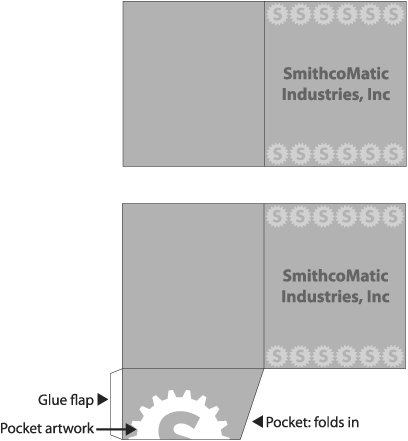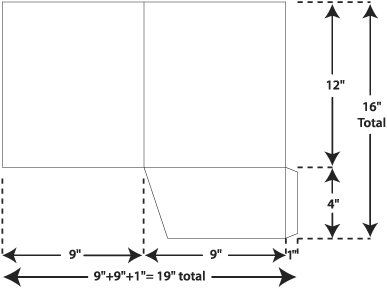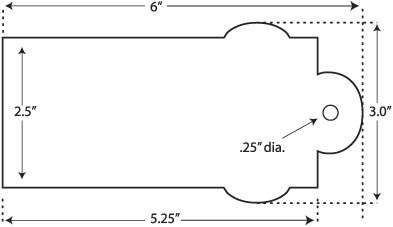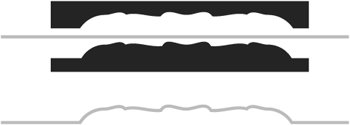Moving Beyond Two Dimensions
| When you start building more complicated piecessuch as pocket foldersit's really helpful to create a dummy of some sort, so you can visualize the finished piece. It's easy to think of how the finished piece will look, but you need to consider how the piece will print and fold so you can create it correctly. An anatomically correct dummy will let you visualize both the inside and outside and will shed light on the difficulties of positioning tricky artwork. In fact, the challenge of lining all that stuff up in your head may force you to simplify your concept. Consider a pocket folder (Figure 3.27). Folded, its configuration resembles a simple, two-page spread. But take a folder apart so you can see how the pocket and its glue flaps are positioned, and you'll see that the printed piece is rather more complex. Any art falling over the pocket has to be carefully aligned with art on the inside of the piece, and this can present a challenge in design as well as in printing and finishing. Figure 3.27. The outside of the finished pocket folder looks like this......but it should be created like this. Note that the pocket and glue flap affect the dimensions of the piece. How do you build such a piece? Think of it as having an inside and an outside, and build it as a two-page document. As with all printed pieces, build to trim size. But you also have to think in three dimensions, to take into consideration the physical processes of folding and gluing. The complex trimming for a piece like a pocket folder requires a shaped cutter called a die. If possible, obtain artwork for the finished die line to use as the basis of your file, as well as an example of the final configuration. A die line is a drawing of the open, flat piece, with all the folds and cuts indicated. This will help you visualize how the artwork must be positioned on the panels of the pocket folder. You'll also learn a lot about how your files must be created if you disassemble a printed example of a finished pocket folder. You'll see how the thickness of the heavy stock affects artwork at the folds, and you'll see how you must accommodate gluing requirements in your design. Most print service providers who specialize in printing pocket folders can provide vector artwork for standard die lines, which you can use as a guide for building your piece. Since the glue area must be blank to allow glue to adhere to unprinted stock, follow the print service provider's guidelines for the size and position of the unprinted area to ensure that no artwork falls within it (Figure 3.28). Figure 3.28. The inside of the finished pocket folder may look like this......but it prints like this. Ink must not be applied in areas that will be glued. In addition to considering the unfolded size of the folder, you must include the glue flap in the overall size of the piece. In Figure 3.29, the folded size would be 9by12 inches, but the actual size of the artwork is 19by16 inches to accommodate the one-inch glue flap and the four-inch height of the pocket. Figure 3.29. The dimensions of pocket-folder artwork must include the glue flap and the pocket area. It's helpful to take apart a printed example that is made from the cutting die that will be used on your job. This helps you visualize how the artwork should be created. Die CuttingWhen your design requires specially shaped edges or complicated folding and assembly, special dies must be created to score and cut the printed piece. Scoring is the act of pressing an indentation into the stock to facilitate folding the final piece. Die cutting is the process of cutting the printed piece into a custom shape. Packaging and pocket folders are examples of pieces that require both scoring and die cutting. Scoring ensures predictable folding, and die cutting creates the shape necessary for the printed piece to become a pocket folder or package. The die itself consists of sharp steel cutting edges anchored in a sturdy wooden base. Although much of the design of cutting dies is now assisted with computer-driven manufacturing, there is still considerable handwork and skill involved in making a successful cutting die. Provisions must be made to ensure that cuts are clean and complete, scoring is correct, and excess material is safely removed without clogging or damaging the cutting edges. The cutting die is mounted on a specialized, die-cutting press, which uses pressure to score and cut the stock. Most die-cutting devices are platen-based, meaning that the die is a flat surface. But there are also rotary die-cutting presses, which require that the die be affixed to a cylinder. Not all printing companies perform their own die cutting. Some opt instead to contract with companies that specialize in such custom finishing. If you intend to create a specialized piece for which the printer has no existing die, work closely with their finishing department (or the outside finisher, if that part of the job is being outsourced) to ensure that your artwork is built correctly. They can help you understand finishing issues affecting your job, and their advice can steer you away from problematic designs. It's important that you obtain a die line before you finalize your artwork (Figure 3.30). It may be supplied as an EPS or imaged on clear film. Carefully follow the dimensions of the die line as you plan your design, and you'll minimize problems during the finishing process. Figure 3.30. Die-line artwork shows the dimensions of the finished piece and indicates any scores, punches, or perforations. Creating correct artwork for a die-cut piece can sometimes require that you create custom bleed areas that consider the irregular trim of the finished piece. Bleed on a diecut piece is more than just a concentric rind around the trim. A beveled approach is required where colors meet some trim points, in an effort to minimize the chances of color falling in the wrong place on the finished piece (Figure 3.31). Die creation is a combination of art and engineering. Don't embark on creating the art for a piece that will be elaborately die-cut without first consulting with your printer's finishing department or finishing supplier. They may have an existing die line that you can use as a basis for designing your piece, which would reduce job cost. Figure 3.31. Die-cut pieces like this hang tag may require complicated bleed construction. Note beveled treatment where two colors meet (left). Finished piece (right).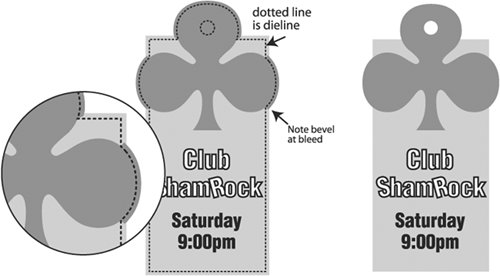 EmbossingEmbossing adds dimension to paper by pressing the paper stock between shaped metal pieces, resulting in a raised surface on the top (reading side) of the paper. Heat and pressure help push the paper into the shape of the embossing dies (Figure 3.32). Figure 3.32. Heat and pressure combined with a pair of shaped dies (top) are necessary to produce an embossed effect on paper (bottom, shown in cross section). Debossing is the same concept, but the shape of the dies creates a convex shape, pushing the surface of the paper down rather than raising it. There are several variations on the concept of embossing:
If you plan to use embossing to enhance your printed piece, consult with the print service provider and any participating outside finishing supplier to ensure that the effect you visualize is possible with the stock you intend to use. Understandably, the stock must have sufficient weight to withstand the embossing process. The pressure and heat used to shape the paper can weaken the paper, especially when attempting to force it into extreme or highly detailed embossing dies. The paper must be flexible enough to accomplish the effect, but strong enough to hold up to the deformation. Any texture inherent in the paper must also be taken into consideration, as well as any other finishing effects (such as folding or perforation) occurring close to the embossed area. The embossing dies themselves are based on artwork such as an EPS file or raster artwork. As you prepare artwork to be used as the basis for embossing, consult with the finishing experts to ensure that you provide artwork in the appropriate format. It's likely that skilled artists will modify your artwork to create the dies and perform handwork on the metal dies themselves to ensure that the final embossed piece matches expectations. Plan for the extra time and cost involved in creating and refining embossing dies. Something this elaborate can't be hurried, but the results can be stunning. Foil StampingOften used as an accent for book covers and packaging, foil stamping uses a heated, raised metal die to transfer decorative foil from a roll of carrier material onto the underlying paper. The foil may be metallic, colored, or iridescent. Some foils are holographic in nature, creating a rainbow or three-dimensional effect when applied. The best results are achieved on smooth, coated papers, since pronounced texture may prevent the foil from adhering uniformly. In addition, foil may not adhere to some coatings such as some waxy varnishes, so you should use aqueous coatings or nonwaxy varnishes before foil stamping. As with embossing, artwork must be created to serve as the basis for the foil stamping die, and it's important to consult with knowledgeable specialists as you begin the process. Foil stamping is most effective in reasonably small areas such as type or patterns. It can be difficult to cover large areas successfully with foil stamping. But if you want a realistic metallic effect, foil stamping can accomplish what could never be equaled with metallic inks. And combined with embossing, foil stamping can create some beautiful effects. |
EAN: 2147483647
Pages: 132
